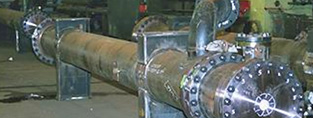
- (03) 5909 8218
- enquiry@fusionweld.com.au
The Importance of Preventive Maintenance for The Pressure Piping System
February 10, 2016

Pressure pipes are the alloy-reinforced conduits that convey dense volumes of fluid from one part of an operating plant to the next. The metal conduits branch and curve through 90° turns, angling to the far corners of power plants, fuel storage depots, and steam boiler containment enclosures. Starting at 15 PSI (103 Kilopascals) and rising swiftly to unimaginably demanding containment ratings, the pressure piping system encompasses more than a complex network of stout tubes. There are valves and control elements, terminating fixtures and flanges incorporated within the network. And every single intricately engineered part of the network bolts together and welds seamlessly in place to form a high-functioning, exhaustively inspected whole that safely withstands immense stresses. Still, even the strongest link can be weakened over time.
A preventive maintenance strategy inspects these components and evaluates performance to create a big-picture perspective of the operating whole. The piping, when first installed, was certified to operate within specified parameters as set by national and international guidelines. Unfortunately, time and environmental influences do their very best to undermine the virtues of the original installation work. The pressure pipes are exposed to vibrations from other parts of the plant, for example. Internal pressures exert transient loading effects on the pressure piping system, and this stress combines with temperature changes to age components. Risks are high in this structure, with high temperatures driving super dense steam, caustic gaseous products reaching their flash points, and fuels changing state as compression apparatus forces an explosive gas to condense. Even the tiniest structural imperfection, the smallest flaw in a weld joint, could spell disaster.
A planned maintenance program detects issues as they occur and highlights these issues for remedial action before they develop into full-blown problems. Imagine the pressure pipes of a superheated boiler undergoing maintenance in this manner. If a defect is discovered, then the valve or pipe is taken out of commission and replaced so that the system is restored to full functionality before it becomes a hazard. The process must be organized and documented, of course, which involves the implementation of a hierarchical framework. Under this methodology, the valves and external surfaces of the pipes would receive attention on a weekly or monthly basis. The system would then be shut down once a year to implement a full maintenance plan, with the integrity of inner pipe surfaces, the viability of weld points, and other potentially hidden flaws becoming exposed as leak tests and vacuum tests created a detailed snapshot of the current condition of the pipes.
Contact Details
Fusion - Weld Engineering Pty Ltd
ABN 98 068 987619
1865 Frankston Flinders Road,
Hastings, VIC 3915
Ph: (03) 5909 8218
Optimized by NetwizardSEO.com.au
Recent Posts
- Compressed Hydrogen Storage Vessels: Material Selection, Design & Australian Standards
- Welding QA/QC in Oil & Gas Pressure Vessel Fabrication – Ensuring Code Compliance
- AS1210 vs ASME VIII Pressure Vessel Code: Key Differences for Australian Projects
- Mitigating Hydrogen-Induced Cracking in Pressure Vessels: Engineering and Material Strategies
- Storage Tank Solutions Australia: Field-Erected, Prefabricated & Self-Bunded Explained
- Reducing Environmental Risks: Self-Bunded Tanks in Australian Oil & Gas Operations
- Precision in Production: How Pressure Vessels Are Manufactured for Industrial Safety
- Shell & Tube Heat Exchangers: Improve Thermal Control & Energy Recovery in Petrochemical & Pharmaceutical Plants
- In-Service Inspection for Compressed Air Receivers for Power Plant Shutdown Prevention
- Power Plant Pipe Spooling Fabrication – Get Rapid, Code-Compliant Spools Ready for Installation
- Field Erected Tanks: Safe, Reliable On-Site Fuel Storage Solutions in Australia
- Custom Pressure Vessel Fabrication for Flammable Gases
Posts 2025
- Compressed Hydrogen Storage Vessels: Material Selection, Design & Australian Standards
- Welding QA/QC in Oil & Gas Pressure Vessel Fabrication – Ensuring Code Compliance
- View all articles…
Posts 2024
- Large Process Vessels: Optimising the Design for Maximum Efficiency [2025]
- Pressure Equipment Management System Installation: Detect Equipment Faults Early
- View all articles…
Posts 2023
- Pressure Piping System Inspection: A Gift of Safety for the Holidays
- Deaerator Inspections by Fusion-Weld Engineering and How They Reduce System Downtime
- View all articles…
Posts 2022
- How Fusion Weld Keeps Up With AS-NZS ISO 9001:2008 Standard
- Boiler Equipment Safety Inspection During the Summer Season
- View all articles…
Posts 2021
- Avoid These Factors and Practices that Contribute to Sealing Damage in Pressure Vessels
- Do's And Don'ts Of Industrial Boiler Inspection And Maintenance From Fusion-Weld
- View all articles…
Posts 2020
- What are the Risks and Hazards Involved in Pressure Vessel Equipment?
- How to Know if Your Pressure Equipment Needs Repair or Replacement?
- View all articles…
Posts 2019
- Factors that Contribute to Pressure Vessel Failure
- Pressure Vessel Regulations in Australia: What are the Mandatory Requirements?
- View all articles…
Posts 2018
- Pros and Cons of Spherical vs. Cylindrical Pressure Vessels
- What are the Different Hazard Levels in Pressure Vessels?
- View all articles…
Posts 2017
- Transportable Pressure Vessels: The Importance of Inspection and Safety Checks
- Fracture Mechanics and Stress Analysis of Cracks in Pressure Vessels
- View all articles…
Posts 2016
Posts 2015
- What Are Deaerators & Feedwater Vessels?
- Precautions and Safety for Compressed Air Receiver Vessels
- View all articles…
Posts 2014
- Demonstrating In-process Inspection Procedures
- Static Grounding Practices and Standards
- View all articles…